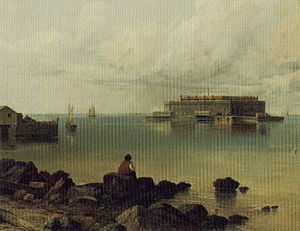Fort Lafayette
| Fort Lafayette | |
|---|---|
| Hendricks Reef, offshore of New York City borough of Brooklyn, New York | |

Fort Lafayette, seen from the Brooklyn shore with Denyse's Wharf to the left
|
|
| Coordinates | 40°36′30″N 74°02′19″W / 40.60833°N 74.03861°W |
| Site history | |
| Built | 1815-1822 |
| Built by | United States Army Corps of Engineers |
| In use | 1822-1946 (ammunition storage after 1897) |
| Materials | sandstone, brick |
| Fate | demolished 1960 |
Coordinates: 40°36′30″N 74°02′19″W / 40.60833°N 74.03861°W
Fort Lafayette was an island coastal fortification in the Narrows of New York Harbor, built offshore from Fort Hamilton at the southern tip of what is now Bay Ridge in the New York City borough of Brooklyn. The fort was built on a natural island known as Hendrick's Reef. Construction on the fort began during the War of 1812 and was completed in 1822. The fort, originally named Fort Diamond after its shape, was renamed in 1823 to celebrate the Marquis de La Fayette, a hero of the American Revolution who would soon commence a grand tour of the United States. The fort was demolished in 1960 to make room for the Verrazano-Narrows Bridge; the Brooklyn-side bridge tower now occupies the fort's former foundation site.
Fort Lafayette was in the form of a square set on end, hence its first name of Fort Diamond. It held approximately 72 cannon (references vary) in three tiers, two in casemates and one in barbette mountings on the roof. The design allowed all the cannon in the southwest front to engage enemy ships entering the Narrows, with the northwest front also engaging if ships passed the fort. The fort was designed at the very end of the second system of US fortifications, and is not fully characteristic of either the second system or the third system. The fort was built of sandstone and brick. The fort was, however, vulnerable to bombardment from Brooklyn, and Fort Hamilton was built circa 1830 to prevent this. In the 1840s, as a captain in the Army Corps of Engineers, Robert E. Lee worked on repairs and improvements to the fort.
...
Wikipedia



